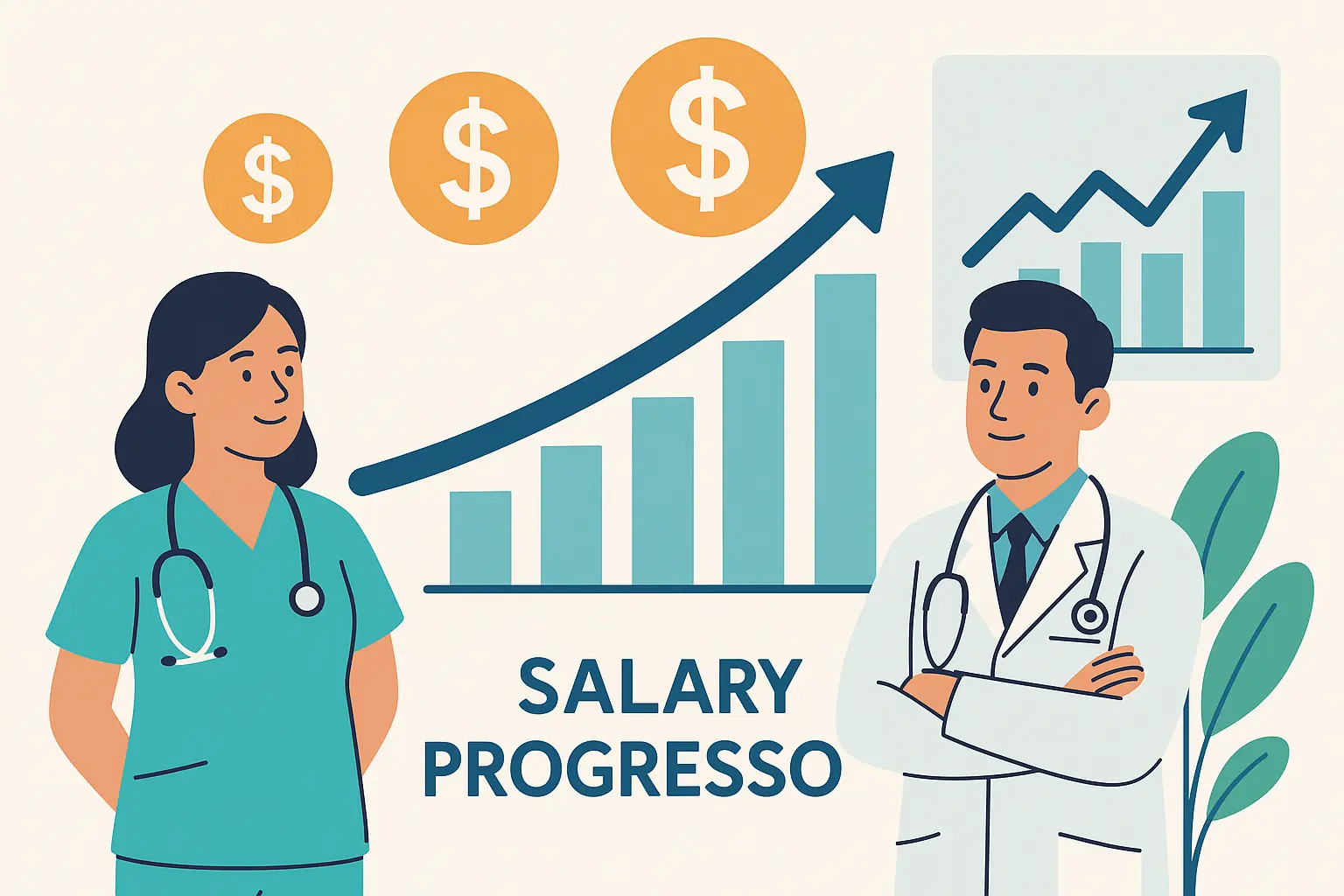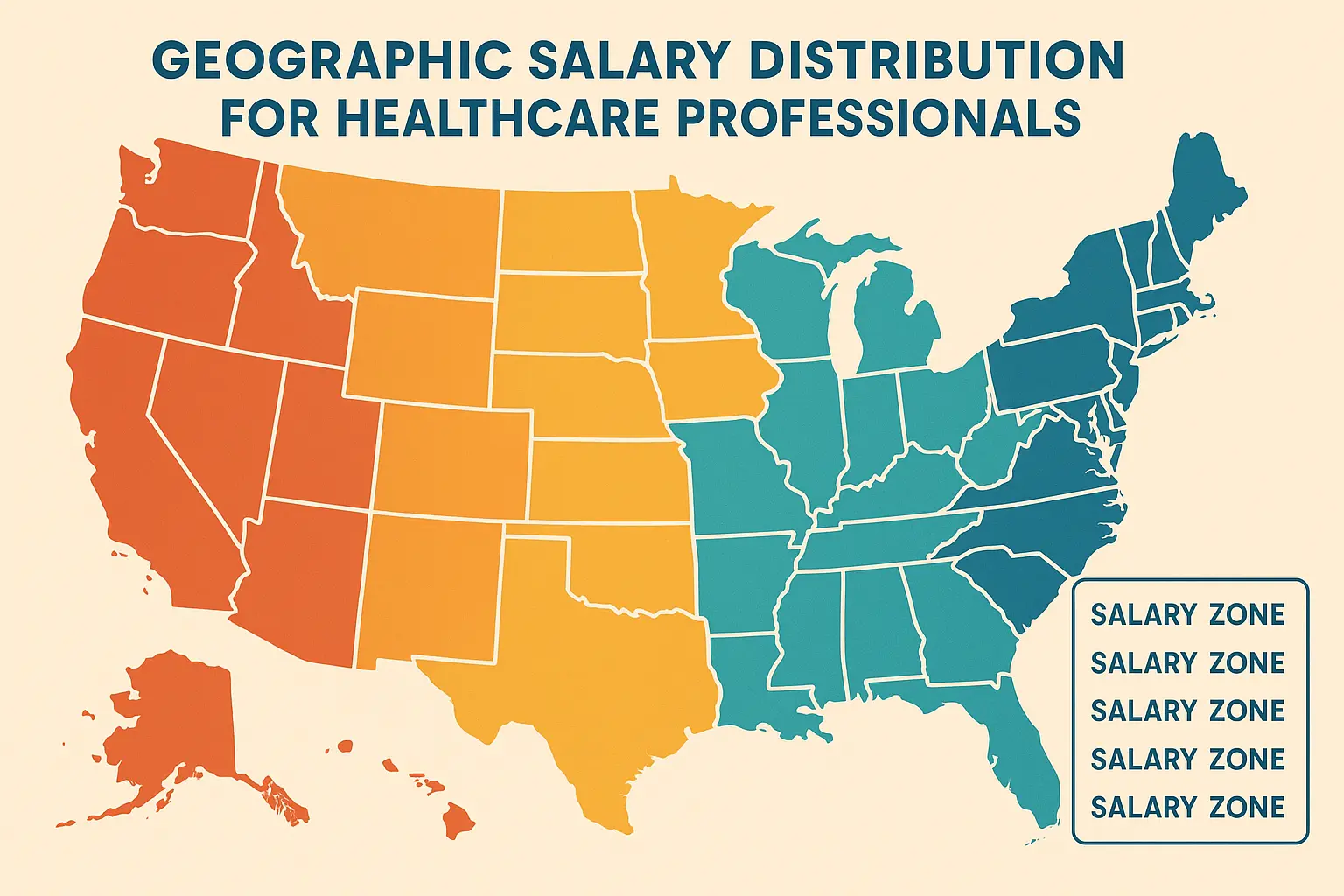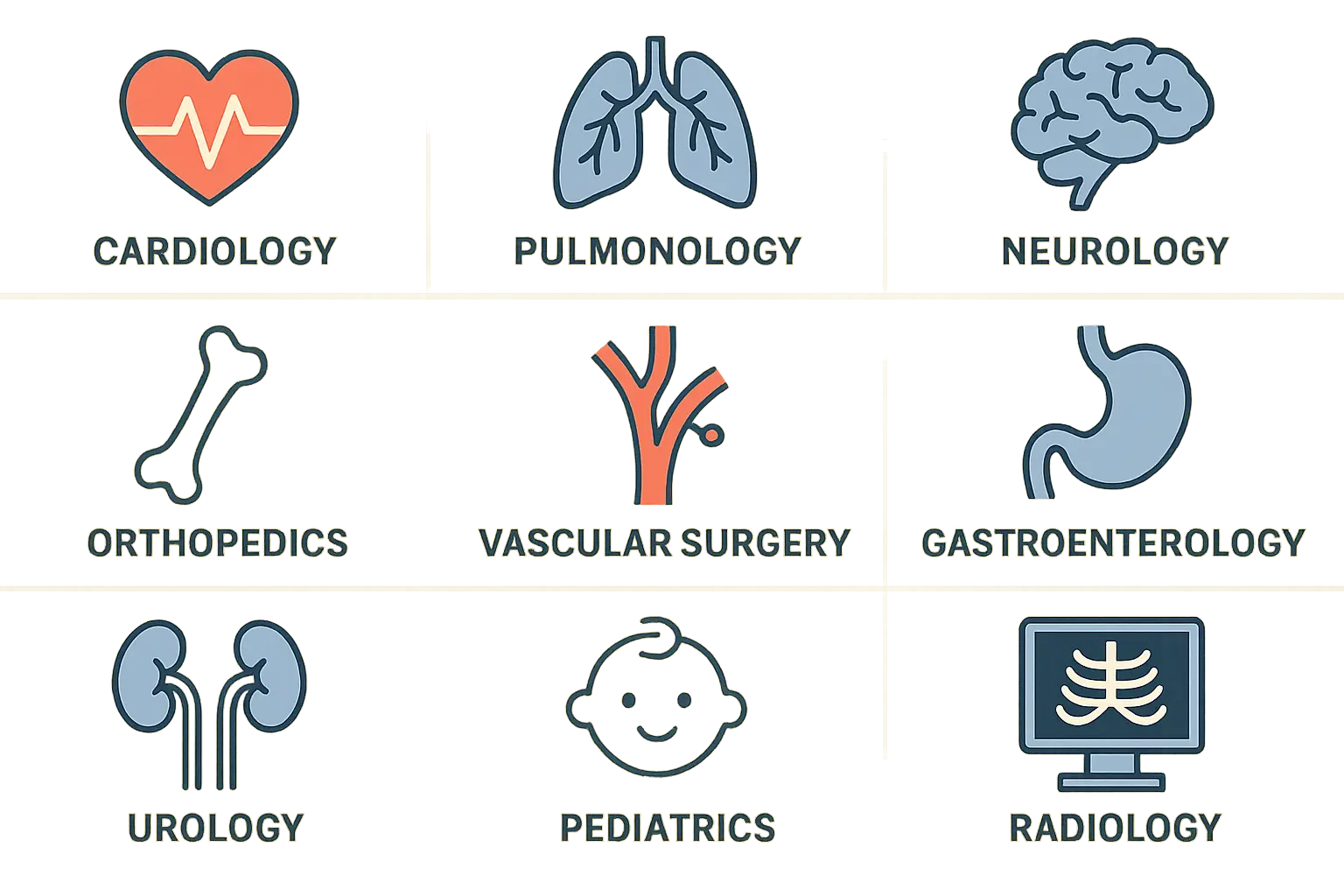Ultrasound Technician Salary: What I Wish Someone Had Told Me Before Starting This Career

Registered sonographers earn a median annual salary of $84,470, or $40.61 per hour, according to the most recent data from the U.S. Bureau of Labor Statistics. This places us among the highest-paid medical technicians, with experienced professionals earning well over $100,000 annually. That kind of ultrasound technician salary makes the field especially appealing for anyone considering a stable healthcare career. The combination of strong earning potential and excellent job security makes sonography an increasingly attractive career choice for healthcare professionals.
When I first looked into becoming an ultrasound tech, I had no clue how much my paycheck would depend on things I’d never even considered. Where you work, what you specialize in, even your shift schedule – all of it can make or break your income. I wish someone had just laid it all out for me straight, without the fluff.
So here’s the real deal. I’ll walk you through actual salary ranges, which specialties pay the most, how location affects your paycheck, and the strategies that actually work for boosting your income. Whether you’re just starting to consider this career or you’re already working and want to make more money, this guide gives you the insider knowledge to make smart decisions.
Table of Contents
- What You’ll Actually Make: The Real Numbers
- Specialization Is Where the Money Is
- Location Can Make or Break Your Paycheck
- Getting There: Education and Certification
- Why This Career Has Staying Power
- Strategies to Boost Your Income
- Building Your Professional Brand for Better Opportunities
TL;DR
- Most ultrasound techs make $60,000-$95,000 annually, starting around $50,000-$65,000
- Cardiac and vascular specialties can boost your pay by 15-25%
- Location matters huge – metro areas pay 20-30% more but cost of living eats into it
- You need either a 2-year degree or 12-18 month certificate program
- Getting certified increases your earning potential by 5-15%
- The field is growing 10-12% through 2032 – way faster than most jobs
- Night shifts, weekends, and travel gigs can seriously bump up your total pay
What You’ll Actually Make: The Real Numbers
Here’s what nobody told me upfront: your starting salary is just that – a starting point. Most of us earn between $60,000-$95,000, which reflects the average ultrasound technician salary, but I’ve seen people nearly double their income by making smart moves with specialization and location.
When I started, I got discouraged by my first paycheck. But this field rewards experience more than most healthcare jobs. You’ll see substantial jumps every few years as you build expertise and add certifications. The key is understanding that your first salary isn’t your forever salary.
The Breakdown: What to Expect at Each Stage
New grads typically start between $50,000-$65,000. Yeah, it might feel low compared to what you hear about other healthcare roles, but stick with me. After five years, most of us are making $80,000-$100,000+. That’s a pretty solid jump.
The average starting salary for sonographers is around $61,000 per year, while experienced sonographers at the top of their pay scale can earn well over $100,000 per year, according to ultrasound education specialists.
The biggest salary jump happens between years 2-5. That’s when you stop being the newbie who needs help with everything and become the tech who can handle complex cases solo. By year three, you’ll likely see a $5,000-$10,000 bump. The real money starts flowing once you hit that five-year mark and can pursue specialized certifications.
Understanding how pay structures work is similar to other healthcare fields, and knowing how to ask for a raise strategically becomes crucial as you prove your value to employers.
| Experience Level | What You’ll Make | What Gets You There |
|---|---|---|
| Starting Out (0-2 years) | $50,000-$65,000 | Basic degree, entry-level certification |
| Getting Good (3-5 years) | $65,000-$85,000 | Specialized skills, additional certs |
| Experienced (5+ years) | $80,000-$110,000+ | Multiple specialties, maybe some leadership |
| Top Earners (10+ years) | $100,000-$123,000+ | Advanced certs, management roles, or high-demand specialties |
These figures show the steady growth of a typical ultrasound technician salary as experience and certifications increase.
Location: The Game Changer You Need to Know About
This is where it gets interesting. Location can literally make or break your paycheck. For example, the average ultrasound technician salary in California can be $20,000 higher than in rural areas, though living costs often offset the difference. We’re talking about $20,000-$30,000 differences depending on where you work.
All of the top 10 highest paying metropolitan areas are in California, according to the BLS.
California, New York, and Massachusetts pay the most, but your rent will eat you alive. A $90,000 salary in San Francisco might give you less spending money than $70,000 in a mid-sized Midwest city. I’ve seen people chase the big city salaries only to realize they were actually worse off financially.
Rural areas pay less upfront, but hear me out. Lower cost of living, shorter commutes, and sometimes signing bonuses or loan forgiveness can make up the difference. Plus, rural hospitals are desperate for qualified techs, which puts you in a good negotiating position.
When you’re looking at different locations, definitely use a salary increase calculator to understand what moving actually means for your finances.
Specialization Is Where the Money Is
Here’s the thing about specializing – yes, it costs money upfront, but I’ve never met anyone who regretted it. Specialized areas can bump your pay by 15-25% above general diagnostic work. The investment typically pays for itself within the first year.
I’ve watched countless techs transform their earning potential by adding just one specialty certification. It’s honestly one of the smartest career moves you can make.
Cardiac: The Premium Specialty
Cardiac sonographers consistently earn the most, often topping the national average ultrasound technician salary with ranges of $75,000–$105,000 annually. The heart stuff is complex, requires extra training, and there aren’t as many of us who can do it well. That scarcity drives up the pay.
Echocardiography has a steeper learning curve than general diagnostic work, but once you’ve got it down, you’re in high demand. Most cardiac techs earn 15-20% more than general diagnostic, and heart problems aren’t going anywhere, so the demand stays strong.
Plus, hearts don’t only have emergencies during business hours. Many cardiac techs pick up overtime work for emergencies, which can seriously boost your annual income beyond that already-premium base salary.
Vascular: Complex Work, Better Pay
Vascular techs earn $70,000-$95,000 because blood vessel imaging is genuinely complicated. You need to understand hemodynamics, advanced Doppler techniques, and complex anatomy. That expertise translates directly to better paychecks.
This specialty combines imaging with physiological testing, making it one of the more technically challenging areas. But that challenge is exactly why it pays more. Many vascular labs also run extended hours to accommodate scheduling, which means shift differentials and overtime opportunities on top of the base salary premium.
Women’s Health: Steady Demand, Good Emotional Rewards
OB/GYN sonographers typically earn $65,000-$85,000, with overtime opportunities in busy practices. The pay might not be the absolute highest, but there’s something special about being part of families’ biggest moments while maintaining steady income.
Obstetric sonography offers job satisfaction that goes beyond the paycheck. You’re doing routine pregnancy scans, monitoring fetal development, and sometimes catching conditions that need specialized care. The demand stays pretty consistent since pregnancy rates don’t fluctuate much with economic conditions.
Many practices also offer flexible scheduling, which can be valuable for work-life balance even if the base pay isn’t the highest in the field.
Getting There: Education and Certification
Most of us complete either associate degree programs (2 years) or certificate programs (12-18 months). The path you choose affects both how quickly you can start working and your long-term earning potential. Generally, employers prefer associate degrees.
I wish someone had explained these differences when I was starting out. It would have changed how I approached the whole process.
Associate Degree vs. Certificate: What’s the Difference?
Associate degree programs give you comprehensive education – anatomy, physics, patient care, plus extensive hands-on clinical experience. Most employers prefer this route because it shows commitment and provides broader healthcare knowledge.
Certificate programs work well if you’re already in healthcare and want to switch to sonography. These focus intensively on ultrasound techniques and get you working faster, but some employers might prefer the broader education from a degree program.
If you’re starting fresh in healthcare, go with the associate degree for better long-term prospects. If you’re already working as a nurse or other healthcare professional, the certificate might be your faster route to career change.
Sonography and cardiovascular technology technicians help doctors at all levels, with associate degree programs teaching technicians how to operate the necessary machinery and relay vital information to doctors, earning a median annual salary of $82,570 according to recent education data.
Prerequisites: The Hidden Time Factor
Most programs require prerequisite courses in anatomy, physiology, and basic sciences. If you haven’t completed these, you might need an extra semester or two before starting your core sonography classes. Don’t let this discourage you – they’re building the foundation you need to succeed.
Between prerequisites, program completion, and certification exams, most students need 18-30 months total to enter the workforce. Many use this prep time to work in healthcare settings to gain patient care experience, which makes them stronger candidates for competitive programs.
Certification: Your Ticket to Better Pay
While not legally required everywhere, ARDMS certification significantly improves your job prospects and earning potential. Certified techs earn 5-15% more and have access to better opportunities.
ARDMS certification isn’t just nice-to-have anymore – it’s becoming the standard expectation. The process involves passing physics and specialty exams, which requires dedicated study time beyond your formal education. Most grads spend 2-3 months preparing, but the investment pays off in higher starting salaries and better job prospects.
You’ll need 30 continuing education credits every three years to maintain certification. This keeps you current with new technologies and techniques, which directly impacts your value to employers.
Why This Career Has Staying Power
The sonography field shows strong growth projections, with employment expected to grow 10-12% through 2032. This isn’t just optimistic thinking – it represents real market forces that will drive demand for decades.
Employment of diagnostic medical sonographers is projected to grow 13 percent from 2024 to 2034, much faster than the average for all occupations, with about 5,800 openings for diagnostic medical sonographers projected each year according to the Bureau of Labor Statistics.
Healthcare systems are already struggling to fill open positions, which puts us in strong negotiating positions for better pay and benefits.
Demographics Working in Our Favor
Baby boomers are aging, and older adults need way more diagnostic imaging. This isn’t a temporary trend – it’s a fundamental shift that will sustain job growth for decades. More routine screenings, chronic condition monitoring, cardiac imaging – all areas where ultrasound plays a crucial role.
Healthcare systems are expanding their imaging capabilities to meet this growing demand, which means more job opportunities and potentially better compensation as employers compete for qualified techs.
Ultrasound Technologists use imaging technology to help diagnose medical conditions, with the 15% growth rate reflecting the increasing reliance on non-invasive diagnostic tools in modern healthcare, according to healthcare industry analysts.
Technology Creating New Opportunities
Portable ultrasound devices and AI-assisted diagnostics aren’t replacing us – they’re expanding where and how we can work. Point-of-care ultrasound is moving into emergency departments, ICUs, and rural clinics where traditional imaging wasn’t available before.
These advances create new practice areas and increase demand for skilled professionals who can adapt to evolving equipment. The key is staying current through continuing education and professional development.
Strategies to Boost Your Income
Smart techs know that base salary is just the starting point. The real money comes from understanding all the ways you can increase your total compensation beyond that base rate.
Shift Differentials: Easy Money for Flexible Schedules
Many facilities offer significant pay premiums for evening, night, weekend, and holiday shifts. We’re talking about potentially increasing your annual earnings by 15-30% just for being flexible with your schedule
Evening shifts typically add $2-5 per hour. Night differentials range from $3-8 per hour. Weekend premiums often add another 10-15% to your base pay, and holiday rates can double your hourly wage.
If you can handle working non-traditional hours, this is one of the easiest ways to boost your annual income. A tech working primarily evenings and weekends might earn $10,000-$15,000 more annually than day-shift colleagues.
On-call responsibilities provide another income stream. Many facilities pay $100-300 per week just for being available, plus overtime rates when you’re actually called in.
Benefits: The Hidden Value
Total compensation includes health insurance, retirement contributions, paid time off, and professional development funding. This stuff can add 20-40% to your base salary value.
Employer-provided health insurance can be worth $8,000-15,000 annually, especially with family coverage. Many hospitals offer premium plans at reduced employee costs, which represents serious value beyond your base pay.
Retirement benefits vary, but many healthcare systems offer generous matching contributions. A 6% employer match on a $75,000 salary adds $4,500 annually to your compensation.
Professional development funding might seem minor at $1,000-3,000 annually, but it supports your long-term earning potential by helping you gain new certifications and skills.
When negotiating compensation, understanding the value of benefits alongside base pay is crucial, and having a professional resume format helps present your qualifications effectively during salary discussions.
Travel and Contract Work: High Risk, High Reward
Contract and travel positions often pay 25-50% above staff positions, though they typically don’t include traditional benefits. Travel techs can earn $35-50 per hour plus housing and travel allowances, potentially reaching $100,000+ annually.
Travel sonography offers the highest earning potential in the field, but it requires serious flexibility. You’ll work 13-week assignments in different locations, often filling urgent staffing needs at premium rates.
The lifestyle isn’t for everyone – you’re away from home, adapting to new equipment and procedures, working in unfamiliar environments. But the financial rewards can be substantial, and you’ll gain experience with different healthcare systems and technologies.
Contract positions in your local area can also provide income boosts without travel requirements. Many facilities use contract workers to cover vacations, maternity leaves, or temporary staffing shortages at premium rates.
Building Your Professional Brand for Better Opportunities
Your resume is often the first impression potential employers have of your qualifications. Healthcare employers increasingly use applicant tracking systems that require specific keywords and formatting to ensure your application reaches human reviewers.
Understanding ATS-friendly resume secrets is crucial for sonographers, as healthcare facilities increasingly rely on automated screening to manage large volumes of applications for specialized positions.
Resume Builder IQ’s healthcare-specific templates and AI-powered suggestions help sonographers showcase their specialized skills, certifications, and clinical experience effectively. The platform’s optimization ensures your resume passes initial ATS screenings while presenting your qualifications in the most compelling way possible. Properly presenting your ARDMS certifications, specialty credentials, and continuing education demonstrates commitment to professional excellence and justifies higher salary expectations. Resume Builder IQ’s AI suggestions help translate technical sonography skills into compelling bullet points that resonate with hiring managers and justify premium compensation.
When building your professional brand, consider exploring hard skills for your resume to effectively showcase your technical sonography competencies and specialized certifications that command higher salaries.
The platform’s skills-based optimization ensures your technical proficiencies are presented in ways that highlight your value to potential employers. This professional presentation can be the difference between landing interviews for entry-level positions versus premium roles that offer significantly higher compensation.
Hospital vs. Clinic Work: Where You’ll Make More
Hospital-employed sonographers often earn 10-15% more than clinic-based positions, plus comprehensive benefits including health insurance, retirement plans, and paid time off. The higher compensation reflects the complexity of hospital cases and the need for techs who can handle emergency situations.
Hospital positions typically offer the most comprehensive benefits packages in healthcare. You’ll likely get premium health insurance, retirement matching, paid time off, and professional development funding. These benefits can add $15,000-$25,000 to your total compensation package.
Outpatient clinics might offer lower base salaries, but they often provide better work-life balance with regular hours and less emergency coverage. The pace in hospitals can be intense, especially in emergency departments where you might handle trauma cases or urgent diagnostic needs. This higher-stress environment is part of why hospitals typically pay premium wages for experienced sonographers.
Recent workplace safety concerns have highlighted the importance of proper protocols in healthcare settings. A recent case involving a hospital sonographer who filed a workers’ compensation claim after experiencing inappropriate patient behavior underscores the need for employers to maintain safe working environments and proper support systems for their staff.
| Work Setting | Average Pay | Benefits Level | Work-Life Balance |
|---|---|---|---|
| Hospitals | $70,000-$95,000 | Excellent | Moderate (on-call required) |
| Physician Offices | $65,000-$80,000 | Good | Excellent (regular hours) |
| Outpatient Centers | $68,000-$85,000 | Good | Very Good |
| Imaging Centers | $72,000-$88,000 | Moderate | Good |
| Travel Positions | $85,000-$120,000+ | Variable | Flexible but demanding |
The Bottom Line
Look, this isn’t a get-rich-quick career, but it’s solid. You’ll make decent money, have job security, and if you play your cards right with specializations and location choices, you can do really well. Just don’t expect to start at the top – like most things worth doing, it takes time to build up to the good money. With the right mix of specialization, certification, and location, your ultrasound technician salary can steadily climb into six figures.
The ultrasound field offers genuine financial stability and growth potential, but success requires strategic thinking about your career path. Starting salaries might seem modest, but the earning trajectory is strong for professionals who invest in their education, pursue certifications, and remain flexible about specialization and location.
Geographic differences can significantly impact your quality of life – a $70,000 salary in a lower-cost area might provide better living standards than $90,000 in an expensive metropolitan market. Consider the total package, including benefits, work-life balance, and long-term career opportunities when evaluating positions.
Specialization remains one of the most reliable paths to higher compensation. Whether you choose cardiac, vascular, or another specialty area, the additional training investment typically pays for itself within the first year through higher wages and better job security.
The industry’s growth projections represent real opportunities for career advancement and salary increases. As healthcare systems expand their imaging capabilities and technology continues evolving, skilled sonographers will find themselves in increasingly strong negotiating positions.
Don’t underestimate the importance of professional presentation in securing the best opportunities. Your qualifications matter, but how you present them can determine whether you’re considered for premium positions or overlooked entirely. Investing in professional application materials is investing in your earning potential.









